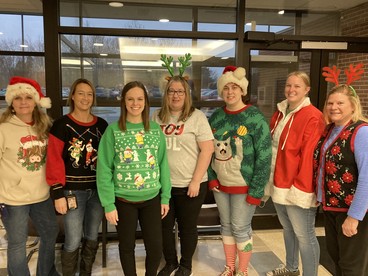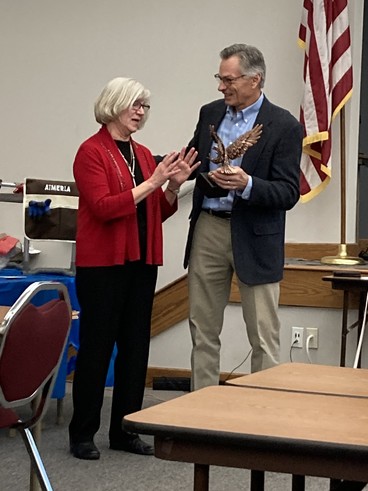Staff Updates
Dr. Leeza Bercaw has taken a position with the United States Department of Agriculture APHIS VS as the epidemiologist for Ohio and Dr. Sara Fleckenstein has taken a position as the State Public Health Veterinarian with the Ohio Department of Health. They will both begin their new jobs in January. We wish them luck in their new roles!
Check for job opportunities with the Division of Animal Health at Careers | Ohio.gov

Highly Pathogenic Avian Influenza Update
Dr. Kristy Shaw, Assistant State Veterinarian
Highly Pathogenic Avian Influenza (HPAI) continues to occur throughout the United States and new detections pop up every week. In the past year, Ohio has had 9 detections of HPAI in 8 counties. One of those was a commercial layer operation and the remainder were backyard flocks. More information can be found at ODA's website HPAI: Biosecurity, Reporting, and Resources | Ohio Department of Agriculture
ODA works closely with our USDA APHIS VS counterparts as well as the Ohio Poultry Association on HPAI response.
Ohio producers are encouraged to be alert and practice enhanced biosecurity. The Defend the Flock Program with USDA has great information on biosecurity for backyard producers. If you have poultry that are showing clinical signs of sickness including lethargy, sudden death, and decreased water consumption – please call ODA immediately. We will walk you through what to do and how we can help.
If you suspect HPAI in your flock, please call the Division of Animal Health at 614-728-6220.
If you have questions about sick wild birds, please call the Ohio Department of Natural Resources (ODNR) at 1-800-WILDLIFE.
|

Epizootic Hemorrhagic Disease (EHD)
Dr. Leeza Bercaw, Field Veterinary Medical Officer
|
Epizootic Hemorrhagic Disease (EHD) is an important, infectious, viral disease of cervids with several endemic serotypes in North America. Whitetail deer (Odocoileus virginianus) are highly susceptible to EHD virus (genus Orbivirus, family Reoviridae). While EHDV can cause clinical disease in other ruminants, infections are commonly subclinical. The virus is transmitted by a small biting insect called a midge (Culicoides). Outbreaks of EHD are seasonal and are seen in late summer and early fall as the insect vectors are killed at the onset of the first hard freeze. Clinical signs of infection include depression, loss of fear of humans, fever, respiratory distress, and swelling of the head, neck, and tongue. There is no evidence that EHDV infects humans.
In 2022, EHDV was detected in both captive and wild cervids in Ohio as shown in the map below (ODNR, 2022). EHDV was also detected in several cattle (not shown on map).
If you see dead or sick wild deer, contact 1-800-wildlife or report the sighting online at Wildlife Reporting System | Ohio Department of Natural Resources (ohiodnr.gov).

ODNR. (2022). EHD in Ohio -2022 Outbreak (Updated 12/8/2022) [Map]

Animal Health Office/ADDL staff in the Christmas spirit!
Ohio Livestock Care Standards
Dr. Ellen Yoakam, Field Veterinary Medical Officer
The Veterinary Medical Officers and Animal Health Inspectors within the Division of Animal Health are responsible for the inspection and regulation of Ohio’s Livestock Care Standards (OLCS). These rules are written into Ohio Administrative Code and include standards of care for dairy, beef, swine, turkeys, broilers, layers, sheep, goats, alpacas, llamas, and equine. The Ohio Livestock Care Standards Board oversees this program and the standards have been in place since 2011.
Complaints and concerns about the care for livestock in Ohio are received and validated, then investigated using a Standard Operating Procedure and checklist specific to the species and concerns. Our office handles a variety of complaints and inspections each year. On average, 40% of the investigations that we conduct are found to be in violation. Often, a component of OLCS complaints and inspections is education to the general public or to livestock owners about care, housing, body condition, etc. When violations are found, a Notice of Violation is issued and steps toward compliance are discussed and followed with further inspection. Penalties are administered if there is failure to comply, and legal hearings may be involved in some situations. Consistently the most common violations deal with animal welfare (housing systems), pasture debris, fencing, bedding, and manure buildup. Other frequent complaints involve absent owners and feed/water conditions.
Mortality disposal concerns are also covered under Ohio regulations and similarly inspected and enforced. Livestock Care Standards do not encompass animal cruelty issues. Those are covered by law enforcement and separate regulations should be reported as such.
For more information and for links and contacts about regulations and reporting please see: https://agri.ohio.gov/divisions/animal-health/livestock-care-standards
What's Up Doc!?
ODA Veterinary Training Opportunties
Dr. Angela Rospert, Field Veterinary Medical Officer
Many professions require continuing education (CE) credits to stay current with their licenses. Veterinarians, including regulatory veterinarians, must also meet CE requirements. For many private practice veterinarians continuing education often focuses on what’s new and current within the profession, the newest drug to treat unresolving skin issues, the latest surgery gadget, or even the most state-of-the-art software program that allows for easier appointment scheduling and contacting clients. As regulatory veterinarians these topics are typically less relevant to our line of work as we do not run a practice, perform surgery, or treat sick animals. (I will note that it is often useful to continue to keep up with the new ins and outs of all aspects of veterinary medicine.) However, there are still many amazing opportunities to gain additional knowledge and skills for our specialized line of work. In the past couple of months I had the opportunity to participate in two remarkable trainings that really allowed me to practice vital field skills.
In early November I traveled to Iowa to participate in the Program Disease Field Skills Course. This course covers several of USDA’s prominent disease programs focusing on Tuberculosis and Scrapie, as well as sample collection. In addition to presentations by knowledgeable speakers, participants were given the opportunity to gain hands-on practice with conducting CCTs (specialized comparative cervical tests for TB responders), blood draws on a variety of species, and rectal biopsies for scrapie testing. This was a great training and has really helped me feel more comfortable performing some of these field skills.
Later in the month I traveled to New York and had the privilege to complete the FADD training (Foreign Animal Disease Diagnostician) to become a certified FADD. This was a very unique experience for numerous reasons. It is a very specialized training typically only available to regulatory or military veterinarians and is held on an island at a BSL 3 (Biosafety Level 3) laboratory. Veterinarians have the opportunity to observe various livestock species with clinical signs of selected foreign animal diseases as well as perform necropsies to see and understand how the disease affects the body systems. This beneficial training provides FADDs the firsthand experience to help best prepare them for when they are called to perform foreign animal disease investigations. FADD training has been the most valuable training I have received after graduating from veterinary school and I don’t foresee it losing that title.
(Please note that for both training opportunities strict protocols and guidelines are in place to ensure that all animals were treated humanely and efforts were made to minimize stress and discomfort.)

Dr. Susan Skorupski retired on November 30th, 2022. She was the Area Veterinarian in Charge (AVIC) for USDA APHIS VS and worked for the USDA for 36 years. Her dedication and commitment to animal agriculture has been unwavering and ODA wishes her well during retirement!
|